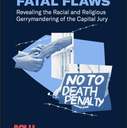
In this month’s episode of Discussions with DPIC, Managing Director Anne Holsinger speaks with Elisabeth Semel, Clinical Professor of Law at the University of California, Berkeley (pictured). Professor Semel joined Berkeley Law in 2001 as the first director of the school’s death penalty clinic and remains the clinic’s co-director, where students have represented individuals facing capital punishment and written amicus briefs in death penalty cases before the United States Supreme Court. In recognition of 38th year anniversary of the landmark U.S. Supreme Court ruling in Batson v. Kentucky (1986), Professor Semel discusses the implications of the Court’s ruling and recent efforts in California to eliminate racial discrimination in capital punishment and jury selection.
In Batson v. Kentucky, the U.S. Supreme Court held that it is unconstitutional to use peremptory strikes to exclude potential jurors based on race. Professor Semel explains that there are two types of strikes during jury selection – cause challenges and peremptory strikes. A challenge for cause requires the prosecution to give a reason why a potential juror could not be fair in a case, while peremptory challenges do not require the prosecution to give a reason for striking the juror. Professor Semel explains that in post-Reconstruction United States, prosecutors excluded Black Americans from jury service “by ensuring that they were not qualified by virtue of rules that made it impossible for them to get on the list of eligible jurors.” As laws were passed protecting Black Americans and enforcing their rights, “peremptory challenges became the alternative way of excluding” these individuals from jury service, as prosecutors were not required to explain their reasoning. In the Batson decision, the Court outlined a three-part test: the defendant must make prima facie showing of discrimination regarding the use of a peremptory strike, the prosecution must then articulate a race-neutral reason for the strike(s), and then the defense must then prove that the reason was pretextual.
Professor Semel says that research shows “that prosecutors continue to disproportionately use these peremptory challenges to remove Black jurors.” In a report published by Professor Semel’s clinic, the findings show that over the course of three decades, the California Supreme Court heard 140 cases with Batson claims but reversed just three of them. The clinic’s report also found, consistent with other academic studies, that implicit or unconscious bias plays a role in a prosecutor’s use of peremptory challenges. Professor Semel explains that “implicit bias is the reliance on racial or ethnic stereotypes that exploit the historical and present-day differences between the experiences of most white jurors and jurors of color.” In efforts to subvert this discrimination, legal scholars and judges have proposed alternative tests. In 2020, the California legislature passed AB 3070, which altered the test established in Batson and implemented an alternative test that went into effect in January 2023. During the same session, the California legislature passed the Racial Justice Act, which allows people charged with or convicted or a crime to raise issues of bias or discrimination based on race, ethnicity, or national origin. In the time since AB 3070 was codified, Professor Semel says “we are seeing more jurors of color, especially more Black jurors, or Latinx jurors [and] we are seeing prosecutors be much more hesitant and reflective about relying” on historical stereotypes.
In discussing more recent efforts in California, Professor Semel praises an April 2024 filing submitted by the California Office of the State Public Defender and several civil rights groups which argues that California’s capital punishment scheme violates the state constitution’s Equal Protection Clause. The California Supreme Court has rejected the idea that only intentional discrimination denies equal protection under the law, allowing attorneys to argue in the filing that “the racially disproportionate impact of the administration of a law can give rise to an equal protection violation.” In support of the claim, the filings offer 15 empirical studies covering various timeframes and regions of California, which conclude “that Black defendants are as much as 8.7 times more likely to be sentenced to death than all other defendants” and “Latinx defendants are as much as 6.2 times more likely to be sentenced to death in California than all other defendants.” Professor Semel explains that these findings are consistent with studies across the United States and “when we look across the administration of the death penalty, there are any number of stages or parts of the process in which race becomes an insidious and practically influential circumstance.”
Professor Semel also addressed localized efforts in California to redress the systemic racial discrimination in capital punishment. Santa Clara County District Attorney Jeff Rosen’s decision to resentence 15 individuals from his county on death row reflects his loss of faith in the fairness of capital punishment, citing racial bias and exorbitant costs. In Alameda County, revelations of prosecutors’ discriminatory jury selection notes in Ernest Dykes’ case is prompting a review of 35 other capital cases, highlighting systemic flaws. Professor Semel believes that these efforts “emphasize the necessity for the California Supreme Court to take the case filed by the Office of the State Public Defender, and other civil rights organizations and leaders, and scrutinize at the level that this particular claim deserves, and this overwhelming evidence of a violation of the state’s equal protection guarantee.”


